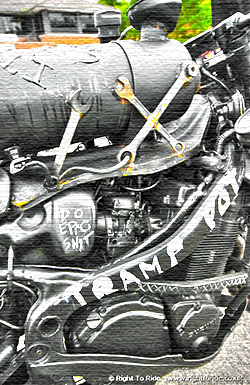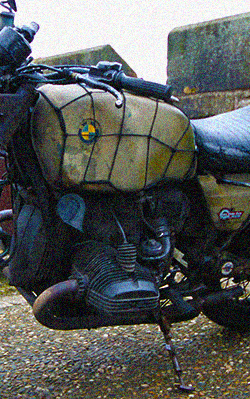 In the latter part of 2014 (November), Right To Ride was given the opportunity to comment on a draft report by the International Transport Forum/OECD entitled “ITF/OECD Working Group On The Safety Of Powered Two-Wheelers ” which was the result of a working group of “experts”.
In the latter part of 2014 (November), Right To Ride was given the opportunity to comment on a draft report by the International Transport Forum/OECD entitled “ITF/OECD Working Group On The Safety Of Powered Two-Wheelers ” which was the result of a working group of “experts”.
To date, as far as we know, the report has yet to be published and it would appear that this document which is intended to be the sum of knowledge of worldwide MC experts, is missing in action.
Its publication was originally intended for March 2015, it was delayed until May and still in August it has yet to be published.
In the meantime, reports on the report, “Some Insights From The ITF/OECD Report – Improved Safety for Motorcycles, Scooters and Moped” were presented in February at the European Motorcyclists’ Forum in Brussels and in March 2015.
Then also in March there was a presentation from the report, “Improved Safety of Motorcycles, Scooters and Mopeds”, at the United Nations Economic Commission for Europe (UNECE) 70th Session of the Working Party on Road Traffic Safety (WP10) round table on the safety of two – wheeled vehicles – entitled “Stemming the tide of lives lost on two wheeled vehicles”!
At Brussels the presentation by Pierre van Elslande, Chairman of the ITF Working Group, highlighted some of the objectives of the report:
• Review the latest research works in the field of motorcycling safety
• Better understand road crash mechanisms and configurations
• Evaluate most effective measures in the framework of a “safe system” approach
• Make recommendations to decision makers in OECD/ITF countries – countries from around the world
In Mr. Van Elslande’s presentation he mentioned the growing role of PTWs in global mobility and he referred to a disproportionate number of casualties of riders and the need to take action on this.
Global Scales
 In Geneva the presentation by George Yannis, Professor, National Technical University of Athens, at first glance, seems that the opinions of riders were side lined as there were quite a number of issues in this presentation which are a duplicate of sections of the report which we challenged as inaccurate and/or not factual.
In Geneva the presentation by George Yannis, Professor, National Technical University of Athens, at first glance, seems that the opinions of riders were side lined as there were quite a number of issues in this presentation which are a duplicate of sections of the report which we challenged as inaccurate and/or not factual.
The original draft of the OECD document showed that in many cases, the experts appeared not to have sufficient knowledge of PTWs to make the assumptions that they did.
The European Motorcyclists Forum in Brussels was made up of and attended by motorcycle organisations, motorcyclists, motorcycle safety experts, government agencies, European Commission, supportive MEPs. Although even in this arena, the substance of the OECD/ITF report was not challenged in any great detail.
However at the UNECE Working Party on Road Traffic Safety round table on the safety of two – wheeled vehicles, the presentation and supportive documents were debated during a special one day round table on exploring the use of road safety legal instruments to address powered two wheeled vehicles safety policies in low and middle income countries.
In fact there was no motorcycle consumer/rider representation – a Manufacturer (industry) representative was there – IMMA International Motorcycle Association. Riders in the past had a special consultative status and permanent representation to these meetings, which meant that not only was there representation in attendance but that representation meant that riders issues/concerns/ could be presented in this global forum.
Now unfortunately we have to rely on our own wits to find out about these issues and what “they” are saying about motorcycling even if two months after the event. Because what is apparent is that the UNECE WP1 (Road Safety) held a debate on motorcycle safety with no motorcyclist representatives!
Critiquing OECD/ITF Draft Report
 Back in November 2014, FEMA – Federation of European Motorcyclists’ Associations and the FIM – Fédération Internationale de Motocyclisme formulated a coordinated response to an OECD-ITF draft report on the safety of Powered Two Wheelers, offering constructive criticism in their 17 page response.
Back in November 2014, FEMA – Federation of European Motorcyclists’ Associations and the FIM – Fédération Internationale de Motocyclisme formulated a coordinated response to an OECD-ITF draft report on the safety of Powered Two Wheelers, offering constructive criticism in their 17 page response.
FEMA commented at that time that the finished document will have a major impact on policy by governments and the EU institutions for many years to come.
Our own critique of the ITF/OECD Report ran to twenty one pages as we assembled a motley crew of experts and trainers for a constructive response, intelligent answers and information to the draft report.
Our response was compiled by Trevor Baird and Elaine Hardy PhD, Right To Ride, Northern Ireland with contributions from David L. Hough, Motorcycle Journalist and writer. USA; Kevin Williams, Survival Skills Rider Training, UK; Alf Gasparro, HELIBIKES, motorcycle safety initiative, UK; Duncan MacKillop, Motorcycle Trainer, UK and J.V. (Jim) Ouellet, Motorcycle Collision Investigator and author, USA.
We concentrated mainly on the issues that we and our own contributors are active in their own field of knowledge therefore we did not comment on all aspects of the document.
We welcomed and appreciated the opportunity offered to enable us to comment with the assistance of others in the motorcycle community from the UK and the USA.
Highlights And Concerns
 Our response is available to download below but some of the excerpts of our comments to the draft report are set out here:
Our response is available to download below but some of the excerpts of our comments to the draft report are set out here:
Furthermore, the inclusion of “filtering” as deviant behaviour is NOT an abnormal or illegal activity. It is included in the Highway Code guidelines in the UK. Recently in countries such as Australia this so-called “deviant behaviour” has now been recognised in some states as a useful and safe means of progressing through traffic ………………………
As an attitude, defensive riding enables the rider to systematically foresee what the riskiest scenario may be at any given moment… to avoid – or cope with – the riskiest situations should they occur.
Excellent statement of what training does NOT achieve even when intended to do so. Practicing emergency routines in isolation fails to link them with the situation in which they are needed (…)
PTWs are not emission free. They emit local and global pollutants and are a significant source of noise.
Our issue is with the text and are a significant source of noise, this text as a standalone statement is incorrect. PTWs have to meet strict noise type approval/global technical regulations, which we understand are being improved at the UNECE. In legal terms manufacturers meet these regulations as do after market exhaust manufacturers so that they can place their PTWs and exhausts/end cans on the market for sale as “road legal” items.
Perhaps the authors may want to review this statement?
In many OECD countries, there is an increasing number of “returning” riders, typically males in the 40-50 year age group, who stopped riding a PTW for a period of more than 5 years and usually return to riding on powerful motorcycles.
This comment appears in other chapters in the document, but there does not seem to be any detailed evidence that this phenomenon (which was first circulated as fact in the UK called “born again bikers”), still exists in the UK or in other countries. These claims need supporting evidence.
It has been said that the European driver licencing regime as it stands is complicated, prescriptive, expensive and discriminatory against lighter and female riders. However anecdotal evidence from those smaller and lighter female riders shows that with tenacity, the correctly adapted motorcycle (lowered seat – lowered suspension) a trainer who understands the need of their trainee and the requirements that enables a rider to pass their test is not unsurmountable. More discussion is required so that the European test is seen as fit for purpose straight out of the box for all riders no matter what their size or gender.
 There needs to be a change in how we train, what we train for and the knowledge we should be applying to a given situation. How do we gather information, how do we interpret it and how we can understand and misunderstand scenarios and ultimately how do we disseminate that throughout the riding population. How do we learn more about accident and near miss causes, more about injuries and more about errors and how do we learn about fixing the problem of repeat causes.
There needs to be a change in how we train, what we train for and the knowledge we should be applying to a given situation. How do we gather information, how do we interpret it and how we can understand and misunderstand scenarios and ultimately how do we disseminate that throughout the riding population. How do we learn more about accident and near miss causes, more about injuries and more about errors and how do we learn about fixing the problem of repeat causes.
Furthermore, due to the different methodologies of gathering data throughout the world, as suggested in the report, it is difficult to grasp the overall problem of collision fatalities which is exacerbated by the use of million (or billion) kilometres (or miles) travelled as a means of identifying risk. The reason for this is that for example in Northern European countries, PTW usage tends to be far less than car usage and seasonal and therefore incompatible with other forms of transport and with PTW usage in southern European and Low Income countries.
As an example of an excellent study, Jim Ouellet, who worked closely with Prof. Harry Hurt on the 1981 “Hurt Report” of 900 motorcycle accidents, is completing a final report on a second study of 304 motorcycle fatalities in California.
With reference to Initial training, what is conspicuous from its absence is any reference to the Initial Rider Training Programme developed by FEMA, the Federation of European Motorcyclists, FIM, Federation Internationale di Motocyclisme and ACEM – the European Motorcycle Manufacturers Association.
Why should access to PTWs be gradual? If one of the factors that affect accident risk is experience, why should access via a gradation of capacity / power be expected to have any effect on accident frequency? It’s logical that new riders will have the same kind of accidents regardless of what machine they ride. Keeping them away from ‘risky situations’ only means that they have to approach those situations at a later date.
Would it not be helpful to have further input from road safety stakeholders in countries such as India or China, in consideration of the high volume of usage of PTWs in these countries? The limitation of comments from these countries suggests that the report has not provided an encompassing global perspective.
Seven Years for An Update
 This draft OECD/ITF report would appear to be an update to the Joint OECD/ITF Transport Research Committee Workshop on Motorcycling Safety held in Lillehammer (Norway) in 2008 – which was somewhat ironic, considering no mention of the Lillehammer workshop was to be found in this latest report.
This draft OECD/ITF report would appear to be an update to the Joint OECD/ITF Transport Research Committee Workshop on Motorcycling Safety held in Lillehammer (Norway) in 2008 – which was somewhat ironic, considering no mention of the Lillehammer workshop was to be found in this latest report.
The workshop aimed to identify the real problems of motorcyclist safety, discussed practical solutions to these problems, and proposed a set of measures and recommendations to improve safety.
Nearly 100 expert participants from 21 countries, attended the workshop and produced a final report with 19 top priorities (links available below).
Let us hope that the outcome of this workshop does not get left at the roadside, even if over seven years ago, that the draft OECD-ITF report whenever it is published, not only follows through on those forward thinking measures and recommendations – especially in consideration of the fact that we highlighted the fact that no mention was made of the workshop in the report!
More importantly that the final report includes or is amended to reflect our and others’ input and it is simply not rolled out now and again!
Leave Any Comments On Right To Ride EU – Click Here
Links & Information
Right To Ride – Comments to ITF/OECD Working Group On The Safety Of Powered Two-Wheelers – Draft Final Report – pdf – Click Here
Motorcycle Safety Forum Brussels – Some Insights From The ITF/OECD Report – “Improved Safety for Motorcycles, Scooters and Moped” – pdf – Click Here
ITF/OECD Report – UNECE Presentation – Road Table – Improved Safety of Motorcycles, Scooters and Mopeds – George Yannis, Professor, National Technical University of Athens – pdf – Click Here
UNECE – Stemming the tide of lives lost on two wheeled vehicles – website – Click Here
UNECE – A Round Table On Safety Of Two – Wheeled Vehicles – presentations – website – Click Here
Download view presentations direct below:
Albania Road Safety Presentation – pdf – Click Here
Motorcyclists Belgium – pdf – Click Here
Powered two -wheelers safety policy in France – pdf – Click Here
Current Problems Of Road Traffic Safety For Two-Wheelers In The Republic Of Kazakhstan And The Ways To Solve Them – pdf – Click Here
Malaysian Institute of Road Safety Research – Policy Overview And Domestic Program – pdf – Click Here
Thailand Motorcycle Accident Situation – pdf – Click Here
USA – Urgent Need for Attention – Click Here
Motorcycle Accidents in Vietnam – pdf – Click Here
IMMA – The Shared Road To Safety A Global Approach for Safer Motorcycling – pdf – Click Here
Exploring the Use of Road Safety Legal Instruments to Address Powered Two-Wheeler Safety policies in “Asian Region” – pdf – Click Here
How does UNECE’s work help improve road safety for motorcyclists? – pdf – Click Here
Workshop on Motorcycling Safety held in Lillehammer (Norway)
Workshop on Motorcycling Safety – Final Report – June 2008 pdf 514kb
Workshop on Motorcycling Safety – Annexes to the Final Report – June 2008 pdf 6.14mb
Top Priorities Identified by the Workshop – June 2008 pdf 155kb


